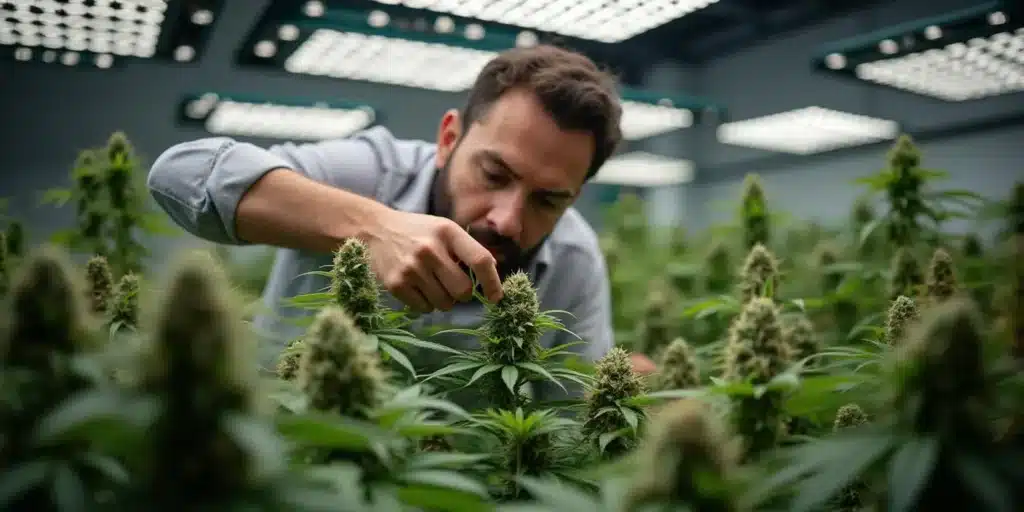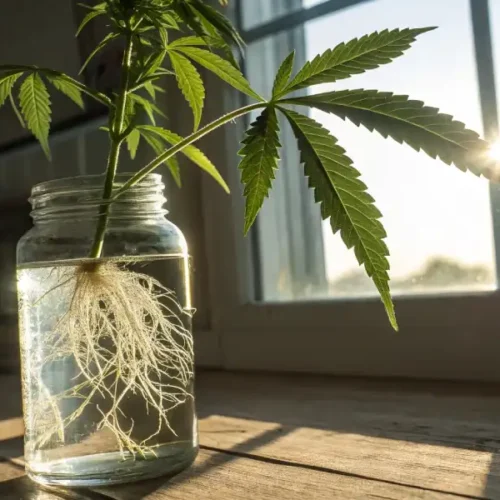If you’re growing cannabis and find that your plants are flowering too soon, you might consider reverting them back to the vegetative stage. One method to help achieve this is to cut off pistils. While it might seem like a drastic step, cutting pistils can be an effective way to reset your plants for further growth. In this guide, we’ll explore the ins and outs of cutting pistils to revert your cannabis plants back to the vegetative stage, ensuring you do it safely and effectively.
Knowing the Need to Revert Cannabis Plants
Reverting your cannabis plants back to the vegetative stage isn’t a decision to take lightly, but it can be beneficial when your plants enter the flowering stage prematurely, or you need them to develop further before flowering. Let’s explore some key reasons why growers choose this technique.
Signs Your Plant Needs to Revert
It’s important to identify when your cannabis plant might benefit from reverting back to the vegetative stage. Common signs include:
- Early Flowering: If your plant has started to flower but is still small or underdeveloped, cutting pistils to revert back to the vegetative stage can give the plant time to grow larger before producing buds.
- Insufficient Growth: If your plant hasn’t developed enough foliage or strong branches to support buds, returning to the vegetative stage can promote healthier growth.
- Environmental Stress: External factors like changes in light, temperature, or nutrients can trigger early flowering. Resetting the plant’s growth cycle by removing pistils gives it a chance to recover.
Benefits of Reverting to the Vegetative Stage
When you decide to cut off pistils to revert back to the vegetative stage, you allow your plant more time to mature, which can lead to several benefits:
- Increased Yield: By returning your plant to the vegetative stage, you give it time to develop more branches and leaves, which will eventually support more buds and increase your overall yield.
- Healthier Plants: Allowing your plants to grow stronger during the vegetative stage helps them resist pests and diseases during flowering.
- Correcting Mistakes: If environmental conditions weren’t ideal, reverting the plant back can provide an opportunity to fix those issues, ensuring a smoother flowering phase later on.
Promos & Deals
The Process of Cutting Off Pistils
Once you’ve decided to cut off pistils to revert back to the vegetative stage, it’s important to understand the process and make sure you’re cutting at the right time and using the proper tools.

Best Time to Cut Off Pistils
Timing is everything when it comes to cutting pistils. The earlier you catch your plant entering the flowering stage, the better. Cutting pistils should ideally be done when the first few pistils appear, but before the plant invests too much energy into flowering. If you wait too long, it may become harder for the plant to revert successfully.
Monitor your plants closely during the flowering stage. When you notice the first signs of pistil development, act quickly to avoid further flowering. This window gives the plant the best chance of returning to a healthy vegetative state.
Tools You Need for the Job
Cutting pistils requires precision, and the right tools can make the process easier and more effective. Here are some essentials:
- Sharp Pruning Scissors: Use sharp, sterilized scissors to make clean cuts and avoid damaging the plant.
- Sterilizing Solution: Clean your tools with alcohol or a sterilizing solution before and after use to prevent infections or diseases from spreading to your plants.
- Good Lighting: Ensure you have adequate lighting when performing the cut to accurately target the pistils and avoid cutting any important leaves or stems.
By using the right tools and cutting at the proper time, you’ll minimize stress on your plant and maximize its chances of successfully reverting back to the vegetative stage.
Steps to Successfully Revert Your Plant
Once you’ve decided to cut off pistils to revert back to the vegetative stage, following the correct steps is important. You’ll want to handle your plants with care to avoid unnecessary stress, ensuring a smooth transition back to vegetative growth.
Identifying the Right Pistils to Cut
The first step is identifying which pistils to cut. Pistils are the tiny, hair-like structures that emerge from the nodes of your cannabis plant during the flowering stage. They can be white, orange, or reddish in color, depending on the plant’s maturity. Focus on cutting pistils that are just beginning to emerge, as these indicate the onset of flowering.
Look for these pistils at the junctions where the branches meet the stem. Cutting pistils at the early stages prevents the plant from continuing its flowering cycle and signals it to return to vegetative growth.
Techniques for Cutting Pistils Safely
Cutting pistils isn’t difficult, but precision is key. Here’s how to do it safely:
- Sterilize Your Tools: Start by sterilizing your scissors to prevent infections. You can use rubbing alcohol to clean the blades thoroughly.
- Locate the Pistils: Gently inspect your plant to find the developing pistils at the nodes.
- Make a Clean Cut: Using your sterilized scissors, make a clean cut just below the pistil, ensuring you don’t damage the surrounding tissue.
- Inspect for Additional Pistils: After you’ve removed the main pistils, check for any others you may have missed, especially if the plant has multiple flowering sites.
By following these steps, you’ll reduce the stress on your plant and improve the chances of successfully reverting it back to vegetative growth.
Caring for Your Plant After Cutting
After cutting the pistils, your plant will need special care to ensure it can successfully revert back to the vegetative stage. This involves adjusting environmental factors like light and nutrients, as well as monitoring its overall health.
Adjusting Light and Nutrients
Once you cut off pistils to revert back to the vegetative stage, one of the most important factors is adjusting your light cycle. To promote vegetative growth, your plant needs more light. Switch your lighting schedule to 18-24 hours of light per day. This extended exposure to light encourages your cannabis plant to return to vegetative growth and delay further flowering.
Nutrient adjustments are also critical. During the vegetative stage, your plant needs more nitrogen than it does during flowering. Switch to a high-nitrogen fertilizer to give your plant the nutrients it needs to grow leaves and branches again. Avoid high-phosphorus or potassium fertilizers typically used during flowering, as these could trigger flowering again.
Monitoring Plant Health Post-Cut
After cutting pistils, keep a close eye on your plant’s overall health. Look for signs of stress, such as wilting leaves, yellowing, or slow growth. If you notice any of these symptoms, it could be a sign that your plant is struggling to revert.
Additionally, continue to check for any new pistils that may emerge. If more pistils appear, you may need to repeat the process and adjust your growing conditions even further to encourage vegetative growth.
By adjusting your plant’s environment and closely monitoring its recovery, you’ll give it the best chance of successfully transitioning back to the vegetative stage and thriving in the future.

Mistakes to Avoid When Cutting Pistils to Revert Back to Vegetative Stage
Even though cutting pistils to revert back to the vegetative stage can be highly effective, there are common pitfalls that growers should avoid. Making mistakes during this process can stress your plant or even cause irreversible damage, which can lead to poor growth and lower yields in the future.
Over-Pruning Your Plant
One of the biggest mistakes growers make is over-pruning when trying to revert their cannabis plants back to the vegetative stage. While it might be tempting to cut off as many pistils as possible, removing too much can cause unnecessary stress to your plant. This stress may inhibit its ability to recover and grow effectively.
To avoid over-pruning, focus only on cutting the pistils and not removing large amounts of leaves or branches. The goal is to stop flowering, not strip your plant of its energy-producing foliage. Remember that leaves play an important function in photosynthesis, which is essential for your plant’s recovery.
Ignoring Environmental Conditions
Another common mistake when attempting to revert a cannabis plant is not adjusting the environmental conditions to support vegetative growth. Once you cut off the pistils, your plant will need a light cycle and nutrient regime that encourages vegetative growth. Without these adjustments, your plant may continue to struggle or attempt to re-enter the flowering stage.
Ensure that your light cycle provides 18-24 hours of light daily and that you’re using the right nutrients, especially high-nitrogen formulas, to support leaf and branch growth. Failing to adjust these factors can severely impact the success of reverting your plant back to the vegetative stage.
Tips for Promoting a Successful Reversion
If you’re looking to cut off pistils to revert back to the vegetative stage, there are a few additional tips to help ensure success. These tips will not only make the process smoother but also promote faster recovery and healthier growth.
Be Patient with Your Plant’s Progress
Reverting a cannabis plant back to the vegetative stage takes time. Don’t expect immediate results after cutting off the pistils. It may take a few weeks for your plant to fully transition back and show significant vegetative growth. During this time, continue to monitor your plant’s health and provide it with the necessary light and nutrients.
Patience is key. Rushing the process or becoming impatient with slow progress can lead to mistakes that set back your plant even further.
Provide Consistent Care After the Cut
After cutting pistils, make sure your plant receives consistent care. This includes maintaining stable temperatures, ensuring proper humidity levels, and providing a steady watering schedule. Stress from inconsistent care can hinder your plant’s ability to recover and grow, so it’s important to maintain optimal growing conditions.
Consistent care will help your plant adjust to the new light cycle and nutrient regime, promoting healthier growth and increasing the chances of a successful reversion.
Long-Term Care for Reverted Cannabis Plants
Once you’ve successfully cut off pistils to revert back to the vegetative stage, the long-term care of your plant becomes essential for continued healthy growth and eventual flowering. This phase requires attentive care to ensure that your plant can recover fully and thrive during its second chance at the vegetative stage.

Gradually Adjusting the Light Cycle
After reverting your cannabis plant back to the vegetative stage, one important consideration is how and when to adjust the light cycle again. While you’ll start with 18-24 hours of light per day, you shouldn’t keep your plants in this extended light cycle indefinitely. Prolonged exposure to constant light can cause stress and may even lead to growth issues over time.
Instead, after a few weeks of recovery, you can slowly reduce the light hours to simulate more natural daylight conditions, ensuring the plant remains healthy. Once you’re satisfied with its size and overall condition, you can prepare for the eventual return to the flowering stage by switching back to a 12/12 light cycle. This adjustment will trigger the plant to flower again under controlled conditions.
Managing Nutrients for Healthy Growth
Nutrient management is just as critical after you cut off pistils to revert back to the vegetative stage. While high-nitrogen fertilizers are important in the initial stages of reversion, as your plant continues to grow, you’ll need to maintain a balanced nutrient mix. This balance ensures your plant develops strong roots, stems, and leaves without over-fertilizing or triggering premature flowering.
Focus on using a nutrient mix that includes trace elements like calcium, magnesium, and iron to support overall health. Regularly monitoring your plants for signs of nutrient deficiencies or toxicities will help you adjust the feeding schedule and prevent any issues that could hinder growth.
Preparing for the Next Flowering Stage
After you’ve reverted your cannabis plant and it has grown back strong and healthy, the next stage is preparing it for a successful second flowering. This time around, with the right preparations, your plant will be more mature and capable of producing higher yields.
Timing the Return to Flowering
Once your plant has spent enough time in the vegetative stage and has developed additional foliage and branches, it’s time to transition back into flowering. The right timing is important to ensure the plant is fully mature and ready for bud production. This typically happens after you’ve seen significant vegetative growth, and the plant is strong enough to support large flowers.
You can encourage this transition by switching back to a 12/12 light cycle and adjusting your nutrients to include more phosphorus and potassium, which are essential for bud development. Gradual changes in environmental conditions will ensure a smooth transition to flowering.
Maximizing Yield During Flowering
To make the most of your decision to cut off pistils to revert back to the vegetative stage, focus on maximizing your yield during the second flowering phase. Keep a close eye on light exposure, humidity levels, and nutrient intake. Consider using bloom boosters and additional phosphorus-rich fertilizers to encourage dense, resinous buds.
As your plant matures in the flowering stage, continue to monitor its progress and address any signs of nutrient deficiencies or environmental stress. The stronger your plant is during this stage, the higher the potential yield, which is the ultimate goal of this entire reversion process.
Troubleshooting Common Issues After Cutting Pistils
After you cut off pistils to revert back to the vegetative stage, it’s not uncommon to encounter some challenges. While the process can be highly effective, several issues may arise during the reversion. Knowing how to troubleshoot these problems will help ensure your plant remains healthy and successfully transitions back into vegetative growth.
Slow or Stunted Growth
One common issue growers face after cutting pistils is slow or stunted growth. This may occur if your plant is under stress or not receiving the right environmental conditions for vegetative recovery. If you notice that your plant isn’t responding to the light and nutrient changes as expected, take a closer look at the following factors:
- Light Intensity: Ensure your plant is receiving adequate light for 18-24 hours per day. Low light levels can slow down growth and prevent the plant from fully reverting.
- Nutrient Deficiency: If your plant is not receiving enough nitrogen or other essential nutrients, its growth may stall. Consider boosting your nitrogen feed during this recovery period to promote vigorous leaf and stem growth.
- Root Health: Poor root health, often due to overwatering or poor drainage, can cause stunted growth. Check the root system and adjust your watering routine to avoid root rot or other issues.
Addressing these factors quickly can help speed up your plant’s recovery, ensuring it develops strong and healthy foliage.
Plant Stress and Leaf Yellowing
Stress is another challenge that can arise after cutting pistils. Cannabis plants may experience stress from the sudden change in their growth cycle, and this can manifest as yellowing leaves or drooping branches. This stress can be mitigated by carefully managing environmental conditions and ensuring the plant has time to adjust to its new vegetative stage.
If you notice yellowing leaves:
- Check Nutrient Levels: Yellow leaves may indicate a nutrient deficiency, particularly nitrogen. Adjust your nutrient mix to include more nitrogen, which supports vegetative growth.
- Improve Ventilation and Humidity: Ensure proper airflow around your plants and maintain an optimal humidity level of 40-70% to reduce plant stress and support healthy growth.
- Avoid Overwatering: Overwatering can cause root issues and stress. Allow the soil to dry out slightly between waterings to prevent waterlogged roots.
By paying close attention to these signs of stress, you can help your plant recover quickly and continue growing strong.
Maximizing the Success of Reversion: Best Practices
Reverting a cannabis plant back to the vegetative stage can be a successful strategy when done carefully. By following best practices, you can increase the chances of a smooth and effective transition. These practices also help ensure that your plant thrives and produces a high-quality yield during its second flowering stage.
Maintaining a Consistent Light Cycle
Light is one of the most critical factors for the success of the reversion process. After cutting pistils, ensure your plant receives a consistent 18-24 hours of light daily to promote vegetative growth. A reliable light schedule helps prevent the plant from re-entering the flowering stage prematurely.
Keep your grow lights at the appropriate distance from your plants to avoid light burn but still provide strong enough light for optimal growth. Regularly check your timers to ensure the light cycle remains consistent, as interruptions can cause stress or push your plant back into flowering mode.
Pruning and Training for Future Growth
After reverting to the vegetative stage, your cannabis plant will likely need some pruning and training to direct its growth. Removing any damaged or excess leaves will help redirect energy to the areas that need it most. Training your plant through techniques like low-stress training (LST) can encourage even growth and improve light exposure to all parts of the plant.
These techniques not only promote healthier growth during the vegetative stage but also prepare your plant for more robust bud production during the next flowering stage.
















